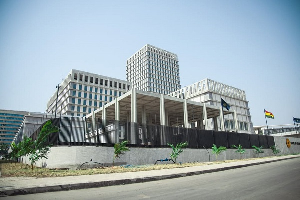In the recent past, the Ministry of Gender, Children and Social Protection has taken notice of some publications on the Livelihood Empowerment Against Poverty (LEAP) programme. One of such publications was published by policy think tank IMANI. The IMANI article in particular, was on what it called “IMANI’s initial verdict on LEAP and what can be done to get value for money”.
The Ministry acknowledges the verdict that some writers have passed on the programme that it is “having impact on the extremely poor beneficiaries per the result of the impact assessment by the Institute of Social, Statistical and Economic Research (ISSER) and North Carolina University in the USA”.
The MoGCSP acknowledges that there is a lot more to do to further improve the LEAP program - which many agree is having a positive impact on the extremely poor. We would like to clarify that social protection in Ghana includes not only LEAP but several other programs that are implemented to complement each other. These are discussed in more detail subsequently.
Need to Strengthen Social (SP) Protection Coordination and Avoid Duplication
Strengthening coordination of social protection in Ghana has been a key issue and continues to be a work in progress. The Ministry of Gender, Children and Social Protection (MoGCSP) received a Cabinet approval as a lead agency for coordinating social protection programs in Ghana. A memorandum of understanding (MoU) with other Ministries, Departments and Agencies (MDAs) exists and data is being shared between LEAP, National Health Insurance Scheme (NHIS) and Labor-Intensive Public Works (LIPW).
To facilitate the complementarity of Social Protection interventions to ensure synergistic benefits, an inter-sectorial Social Protection Technical Committee (comprising the management of key SP interventions) was inaugurated in January 2015 and has since been working together.
The Technical Committee is complimented by a Social Protection Sector Working Group which includes related ministries, development partners and civil society. This group provides technical and operational insight to the Technical Committee. MoGCSP is also implementing a Cabinet approved institutional framework from the national to the district level to effectively coordinate the implementation of SP interventions.
The overarching objective of the LEAP programme, being implemented within the MoGCSP, is to reduce poverty by smoothening consumption among the extremely poor households with eligible members - Orphan and Vulnerable Children, Aged 65 years and above, and persons with severe disability without any productive capacity.
The design of LEAP includes linking of beneficiary households to complimentary productive social interventions that will enable them move out of extreme poverty. LEAP is also currently working with Research and Academic Institutions to develop, implement, and evaluate engagement of LEAP households’ productive inclusion as a result of SP interventions.
Coordinated Targeting Mechanism for Potential Beneficiaries
Targeting the appropriate beneficiaries is at the core of our work. Using appropriate tested means of target is key to promoting efficiency and reducing corruption (at all levels) as the implication of wrongful targeting is immense. A number of targeting approaches has been explored in the past, the Common Targeting Mechanism (CTM) with an MoU signed by five ministries (Employment and Labour Relations, Health, Education, Food and Agriculture, and Local Government and Rural Development) in April 2010.
In a continued effort to implement effective targeting, the Proxy Means Text (PMT) questionnaire, tailored to fit the Ghanaian context, was subsequently developed and pre-tested in 2012; the LEAP program has been using the PMT for targeting since 2013 and it is being used currently to target 60 000 more beneficiaries. As of May 2015, a National Targeting Unit (NTU) was established within MoGCSP to facilitate a coordinated approach to the implementation of the CTM. The NTU is currently working on the development of the Ghana National Household Registry (GNHR), a single registry
database on extreme poor and poor households to be used for beneficiary selection by all social protection interventions. The objective of the GNHR is to facilitate effective coordination of social protection interventions, and to promote efficiency by reducing duplications of effort. The first phase of data collection of the registry will take place in the Upper West Region and data gathered will be available for use in January 2016.
Development of National Social Protection Policy to Enhance Coordination A national social protection policy is being developed to foster coherence in approach and ensure that all social protection interventions are operating within certain set national guidelines and standards. The policy also ensures sustainability of interventions.
The overarching objective of the policy is to eliminate extreme poverty in Ghana by 2025. The policy will address sustainable financing mechanisms for all social protection interventions including LEAP, targeting and selection of beneficiaries, and a common monitoring and evaluation framework to measure the success of implementation of the policy.
A draft policy document currently exists and is being reviewed by key stakeholders, including the MoGCSP, MoF, MLRD and development partners. Upon completion of this initial review, the policy will be shared with a broader stakeholder audience for input, prior to completion. The National Social Protection Policy is expected to be completed by September 2015.
Promoting LEAP Program Efficiency
The LEAP program has its own M& E and Result Framework, which is used by the Ministry as well as independent monitors including civil society organizations to monitor progress of implementation and results. These M & E reports are available for public viewing.
Subsequent to the piloting of the e-payment, the Ministry plans to roll out a full electronic payment to LEAP beneficiaries across all LEAP districts from January 2016. In the meantime, LEAP conducts several monitoring activities to ensure appropriate payments to beneficiaries. Since August, 2013 LEAP has implemented timely payments.
Graduation of LEAP Beneficiaries to Promote Sustainability
As discussed previously, a variety of intentional coordination efforts are underway which are all aimed to promote graduation of LEAP beneficiaries and sustainability of the interventions.
As part of the SP policy discussions, it is proposed that LEAP, NHIS, School Feeding and LIPW will constitute the initial basket of social protection programs, which will be coordinated and targeted at extremely poor households.
A combination of these efforts will allow for synergies and complementarity of services leading to cost-savings for government. With strong social mobilization and use of ICT, it is expected that strong social inclusion will be realized. An impact evaluation will be undertaken to document results.
It important to note that with the benefits seen so far, LEAP is delivering value for money and it will empower the beneficiary to break out of the cycle of poverty. This, the Government of Ghana is leaving no stone unturned to achieve.
Regional News of Thursday, 24 September 2015
Source: LEAP Management Unit of the MGCSP













